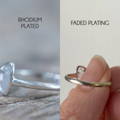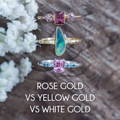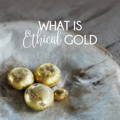Your Cart is Empty
Why does your white gold turn yellow?
And how to fix it?
Updated November 2025
Is your white gold jewelry turning yellow or losing that cool white shine?
Don’t panic. It’s not bad karma, sebum or a sign you bought cheap jewelry. It’s just your ring doing what gold naturally does: revealing its true colors.
White gold fades because it’s plated with rhodium, a thin layer that eventually wears off to show the warm tone of the gold underneath. It happens to everyone. The daily wear and tear, soap, lotions and sweat speed it up, and your ring becomes a little more… honest.
TDLR:
When the rhodium plating wears off, white gold shows its true golden hue underneath.
Everyday things like soap, sweat and skincare products can make the rhodium plating fade faster.
The only way to bring back that bright white finish is rhodium replating, a polish or cleaning won’t do the trick.
Keep reading to find out how white gold gets its color in the first place, what makes white gold fade, and why that’s not a flaw.
If you’re wondering why your white gold wedding band or the prongs of your engagement ring are turning yellow, keep reading for the longform answer.
What Is White Gold? Is White Gold Real Gold?
White gold is real gold. It’s not fake or plated base metal. It simply looks white because it’s mixed with other metals. So yes, it’s still genuine gold, just alloyed to appear lighter.
And here’s where things get interesting. Gold in its purest form is never white. Pure gold is always yellow. In fact, white gold doesn’t exist in nature. There’s no such thing as pure white gold.
So how does white gold get its color?
If gold is yellow, then how is white gold made?
Jewelers refer to gold in its pure form as 24 karat gold. Pure gold is too soft to be used in jewelry. That’s why it’s mixed with other metals that make it durable enough to be worn daily. These metals may include copper, silver, nickel, palladium and zinc. The addition of other metals changes the color of the gold. That's literally how white gold is made, and how you get different gold colors like yellow gold and rose gold. The final step is rhodium plating, which gives it that mirror bright shine.
At Gardens of the Sun, we mix our own gold alloys with ethical gold, and add metals like copper and silver to it. We use 18 karat gold, which means that 18 out of 24 parts is pure gold. That’s 75%, and that’s also why in some countries, it gets a 750 stamp rather than an 18k stamp.
The remaining 25% is where the mix of metals comes into play. A higher amount of copper will turn the gold to rose gold. Mixing it with silver, zinc, nickel or palladium will turn it to pale gold, or what you know as white gold.
Does white gold use nickel?
Back in the day, people used nickel to give white gold its shiny white metal look. It's cheap and very effective at making the gold look much whiter. However, many people (myself included!) are allergic to nickel and most quality jewelers won't use nickel anymore. Likewise, Gardens of the Sun does not use any nickel in any of our jewelry.
At Gardens of the Sun, we used silver and zinc as the base alloy for our 18 karat white gold until late 2022. White gold based on zinc or silver still has a distinct golden glow, but it looks more pale and greenish.
In late 2022, we shifted to using a palladium alloy for our white gold. Palladium gives the gold a gray tone and less of a warm yellow hue. Palladium is more expensive than nickel and has a higher melting point, which makes white gold more expensive and more labor intensive to work with.
What color is white gold?
Just like how there are many shades of white, white gold can have different colors. The color of white gold depends on the alloy, both which other metals it’s mixed with, and the ratio of these other metals are used.
White gold with only silver and zinc tends to be pale and greenish gold. White gold with nickel looks even more pale, less green, more gray. White gold with palladium looks a pale, dull gray. White gold that's rhodium plated looks like the color of rhodium: that white metal shine.
For white gold as well as yellow gold and rose gold, 14 karat gold tends to be less golden in color than 18 karat gold, since it has a lower gold content.
IS WHITE GOLD RHODIUM PLATED?
Natural white gold isn’t exactly white. Historically, jewelers want white gold to match the color of platinum, a rare metal with a hefty price tag. But white gold based on zinc or silver still has a distinct golden glow, as does white gold with a higher gold purity like 14 karat or 18 karat. So to achieve this white metal look, white gold is often plated with rhodium.
Does white gold fade? Does white gold tarnish? Does white gold rust?
When someone says white gold fades or tarnishes, they’re most likely referring to the rhodium plating fading to reveal the white gold underneath. And this white gold can look yellow, which is the reason why your jewelry was rhodium plated in the first place.
White gold itself does not discolor or change color, and the color will remain the same.
What does white gold look like when the rhodium plating wears off and it starts turning yellow? You’ll notice a warm, slightly golden hue showing through, usually first on prongs or the inner band. The bright white surface gets patchy and the yellow tint gets more obvious with time.
SO WHY DOES WHITE GOLD TURN YELLOW?
Most white gold jewelry is rhodium plated. As the rhodium plating is only a thin top layer, the rhodium plating tends to fade over time. Everyday wear, like rubbing and scratching, wears down the rhodium fastest on prongs and spots that get the most contact.
Since the top layer has eroded, there’s no way to clean white gold that has turned yellow back to white gold. In fact, by obsessively cleaning and polishing it you would remove more of the rhodium plating, and reveal even more of the underlying yellow toned gold.
IS IT BAD IF WHITE GOLD TURNS YELLOW?
White gold doesn’t turn yellow because of oxidation and tarnish. It turns yellow because that’s its natural color.
So, it’s not ‘bad’ at all if white gold turns yellow! In fact, some people are loving this natural look more.
HOW CAN I PREVENT WHITE GOLD FROM TURNING YELLOW?
Bad news is: you can’t prevent white gold from turning yellow, or rhodium plating from fading. The breakdown process is normal and inevitable. But you can slow down its process by taking good care of your jewelry. Try to avoid getting your white gold jewelry wet, soapy or dirty. Take it off before showering, swimming or splashing around in the ocean. Don't wear it to the gym or your yoga class. Plus you can opt for an alloy that’s less yellow to begin with.
white gold maintenance and care
To clean white gold jewelry, soak it in warm water with mild dish soap, gently brush with a soft toothbrush, then rinse and pat dry. This keeps it shiny but doesn’t fix yellowing. Only rhodium replating can make white gold white again.
With daily wear, rhodium plating lasts one to three years. Rings fade faster than earrings or necklaces because they tend to have more contact with other surfaces. If your white gold band is turning yellow, it’s time to replate.
Is there white gold that doesn’t turn yellow?
Whether or not white gold turns yellow depends on the base alloy, so the gold used underneath the rhodium plating. White gold itself does not change color, and the color will remain the same. So to prevent white gold changing color, choose a white gold alloy that's more white than yellow to begin with, and that does not need to be rhodium plated.
The first thing to do is ask your jeweler what kind of alloy they use for their white gold. If it’s a silver-based alloy, your jewelry will likely turn yellow over time. If it’s a nickel-based alloy, be aware it may trigger allergies. If it’s a palladium-based alloy, your white gold is unlikely to turn yellow, but it may lose some brightness over time.
Can you turn yellow gold into white gold, and vice versa?
In case you’re wondering whether you can turn yellow gold into white gold, or whether you can change white gold to yellow gold, the answer lies in the plating.
It is possible to add a yellow gold, rose gold or rhodium plating to any piece of jewelry you already own, unless there are very fragile gemstones that may not be able to withstand the electroplating process.
Keep in mind however, that over time the plating will wear off, and that this is not a permanent solution.
WHY IS WHITE GOLD MORE EXPENSIVE THAN YELLOW GOLD?
Creating white gold jewelry involves either additional steps (rhodium plating) or more expensive metals (palladium) that may be harder to work with. If your white gold jewelry contains palladium, remember palladium is a rare metal, and with a price tag. More expensive than a silver or nickel based alloy. Moreover, palladium is harder to work with than gold, so it’s more labor intensive. That’s why white gold is more expensive than yellow gold.
If your white gold is rhodium plated, there’s additional labor and materials involved in the rhodium plating process.
You white gold is often more expensive and you can expect to pay more for a white gold ring than a yellow gold ring of the same quality and purity.
WHAT’S SO SPECIAL ABOUT GARDENS OF THE SUN ETHICAL GOLD?
We partner with 25 artisanal indigenous women miners in Indonesian Borneo. We pay them a premium for their pledge against the use of mercury and cyanide. Plus, the miners operate legally without deforestation.
These women are our partners, not our employees - meaning they can make more profit for themselves on top of a stable income. In fact, studies by Yayasan Tambuhak Sinta, the University of British Columbia and Canadian International Resources and Development Institute found this partnership has created access to finance, increased income and more gender equality, women’s leadership and governance.
In the process, your gold jewelry avoided releasing an estimated 44 kg of mercury into the world.
Read more about our ethical gold.
WHY CHOOSE WHITE GOLD JEWELRY?
White gold is a popular choice of metal for engagement or wedding rings. White gold is timeless, versatile and highlights the sparkle of diamonds. Its rhodium layer enhances durability and shine, though it needs occasional replating. If you love the bright look of platinum but want something lighter on the wallet, white gold is your best choice:
It suits both warm and cool-toned skin
Looks great with any gemstone color, especially white gemstones and diamonds come out best against white metal
It’s chic and elegant
Rhodium plating gives your jewelry a more scratch resistant layer
How to make white gold white again?
Are you looking to get that white metal glow back? This is not something you can fix at home. There's no other way around it - your white gold jewelry will have to be re-plated to get that platinum shine again. It's not a complicated process and your local jeweler should be able to do it for you, either in house or at one of their partners.
If you purchased your ring from us, you're welcome to send it back and we'll gladly dip that piece in rhodium for you. In fact, we've done it for many of our clients. You can purchase rhodium plating in Bali here.
FAQ About White Gold Turning Yellow
What causes white gold to turn yellow?
White gold turns yellow as its rhodium plating wears off. Rubbing, scratching, sweat, soap, household cleaning products and skincare products all speed up this process, especially on spots that stick out, like prongs or the inside of your ring.
Can I fix yellowing white gold at home?
Nope, you can’t fix yellowing white gold with any home remedy. Once the rhodium plating is gone, only a jeweler can restore the white finish through replating.
Will cleaning remove the yellow tint from my ring?
No, cleaning and polishing can’t bring back the white color of your white gold jewelry. Once the rhodium plating has worn off, only replating will restore the shine.
How long does rhodium plating on white gold last?
Rhodium plating usually lasts anywhere from 1 to 3 years with regular wear. If you’re rough on your rings or wear them daily, you may see yellowing sooner, especially on the parts that get the most action.
How often should I have my white gold replated?
If you want to keep that crisp white shine, have your white gold jewelry rhodium replated every 1–3 years. Rings and prongs tend to need it more often since they see the most wear.
Does white gold tarnish, fade or rust?
White gold doesn’t tarnish or rust, but its rhodium coating does fade, exposing the gold’s natural yellow tint underneath.
Is white gold more expensive than yellow gold or rose gold?
White gold is usually a little pricier than yellow gold or rose gold, because it often uses rare metals like palladium and requires rhodium plating, both add to the cost.
Does white gold cause allergies?
Sometimes. Nickel based white gold alloys can trigger allergies in some people. We use nickel free white gold at Gardens of the Sun for that reason.
Is white gold better for engagement rings than yellow gold?
White gold is popular for engagement rings because it makes diamonds pop and looks modern. Just know that it does need rhodium replating over time to keep that icy shine.
how much gold is in white gold?
Just like yellow gold, the gold content depends on the karat. 18k white gold contains 75% pure gold, with the rest made up of white metals. For more information about gold content and gold purity, read our blog post about gold karats.
What’s the difference between white gold and yellow gold?
The white gold vs yellow gold difference lies in the gold color and supporting metals. Yellow gold is gold in its natural state, mixed with metals like copper for strength. White gold is gold mixed with white metals and finished with rhodium plating for a pale, silvery color.






















